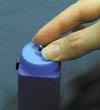
Wet Flies: The K.C.K. designed by Kelly Davison
Hook: Daiichi 2220, #6-#8
Thread: MFC 8/0, Red
Tail: Red Hackle Fibres
Body: Yellow Crystal Chenille
Hackle: Red or Brown Saddle
Wing: Teal Flank Fibres Topped with 4-6 Strands of pearlescent Crystal Flash
Tying Note: Experiment with different colors and color combinations of Crystal Chenille.
Add Daiichi hooks to your order and receive $5.00 USD off the purchase price. Use Coupon Code PRFB2015 at check out. (limit one per customer)
Kelly Davison’s K.C.K. (Kelly’s Coho Killer) has been a long standing favourite for targeting returning Coho on the rivers and sloughs of the Fraser Valley. The K.C.K. is a modern example of a wet fly, a tying discipline that has slipped in popularity in recent years. With the evolution and growth of nymph patterns wet fly patterns have taken a back seat. Despite this pattern shift wet flies are still worthwhile additions to any fly box, be it lake, stream or river for returning salmon and steelhead or resident trout.
With a long standing history over 100 years old, pre dating dry flies, wet flies are still popular choices in many areas of the world today such as the British Isles. Using teams of wet flies from a drifting boat is a common tactic for lochs and lakes. Here in Canada traditional wet flies including the Dark Montreal, McGinty and Red Ibis are still popular in Quebec and theMaritime Provinces. Here in the west wet flies seem to have established a last bastion amongst steelhead and salmon fly fishers. Stillwater fly fishers may beg to differ as the venerable Doc Spratley is still a popular selection. Wet flies suggest a variety of prey items including emerging aquatic insects and drowned terrestrials. Brighter patterns elicit an aggressive territorial response and are favourite attractor choices.
Typically simple dressings, wet flies do have proportional considerations to ensure patterns swim true in order to garner a grab. Tails are typically one half the shank in length and can be constructed from a variety of materials. Quill sections and hackle fibre tails are the most popular choices. Many wet fly patterns feature ribbing of some kind. Ribbing suggests body segmentation, a degree of attraction or reinforcement. Four turns of ribbing is considered standard. Wet fly bodies occupy the shank from the rear of the barb forward to the hook eye. A variety of materials can be used including yarns, floss and dubbing. Modern synthetics have made their mark as well. The Crystal Chenille body of the K.C.K is one example. As most wet flies tend to become their most complicated and crowded at the head make a habit of stopping the body two eye widths back from the hook eye. This simple practice provides ample room for hackle, wings and the formation of a neat tapered head.
Hackle is an important wet fly component. Most wet flies feature soft hackle such as hen, partridge or guinea providing life suggesting motion. Cock hackle, such as cheaper Chinese or Indian necks and saddles also work. Pattern recipe or tiers preference typically dictates. Do not be afraid to experiment. There are a number of different hackling styles depending upon the pattern itself or the tiers preference. The Doc Spratley’s characteristic guinea throat is an example of a beard hackle. The K.C.K., as with many wet fly patterns incorporates a semi circular hackle where the fibres radiate around the lower half of the fly. Other wet flies feature full hackles that radiate around the circumference of the pattern. No matter the style hackle fibre tips should extend no further than the hook point unless specified.
There is a knack to getting wet hackles correct. Begin by tying in the feather wet fly style with the convex, shiny or most prominently marked side of the feather facing the tyer along the side cocked back toward the tail on an angle. Leave a small section of exposed stem visible at the tie in point. This technique helps position the feather during the initial wrap. Wind the hackle forward a maximum of 4 wraps directly in front of the body so the hackle fibres flow back along the body. Sparse hackled wet flies work best. Use the thumb and forefinger to sweep, hold and pinch the fibres down and back to form a semi circular hackle. Keep the upper section of the fly clear for the wing. Secure the swept hackle into place with a minimum of wraps to avoid excess thread build up and large crowded heads. Beard hackles can also be formed by stripping a section of fibres from the side of a feather and binding them in place along the “chin” of the fly.
A diversity of materials also factor into wing construction. Marabou, hackle fibres, hair, fur, tail fibres and quill slips are popular choices. Wet fly wings typically extend between one half the length of the tail or to the tip of the tail. Once again pattern specifics or tyer preference plays a role. Effort must be made to place the wing squarely on top of the hook to ensure proper tracking. Use the thumb and forefinger to pinch and hold the wing materials in place on top of the shank. Surround the wing materials with 2 loose but controlled wraps of thread. Once the wing materials are encompassed with tying thread apply pressure to secure. This practice results in the thread pressure being applied from all directions onto the material, using too much thread tension before the material roll the wing out of position over to the far side of the hook due to thread torque. If necessary seat the wing into position by gently wiggling the tips and the butts after the initial tie in. Apply additional secure wraps progressively forward once the butts have been trimmed to avoid knocking the wing out of position. Trim the butts on a tapered to aid in the completion of the head.






